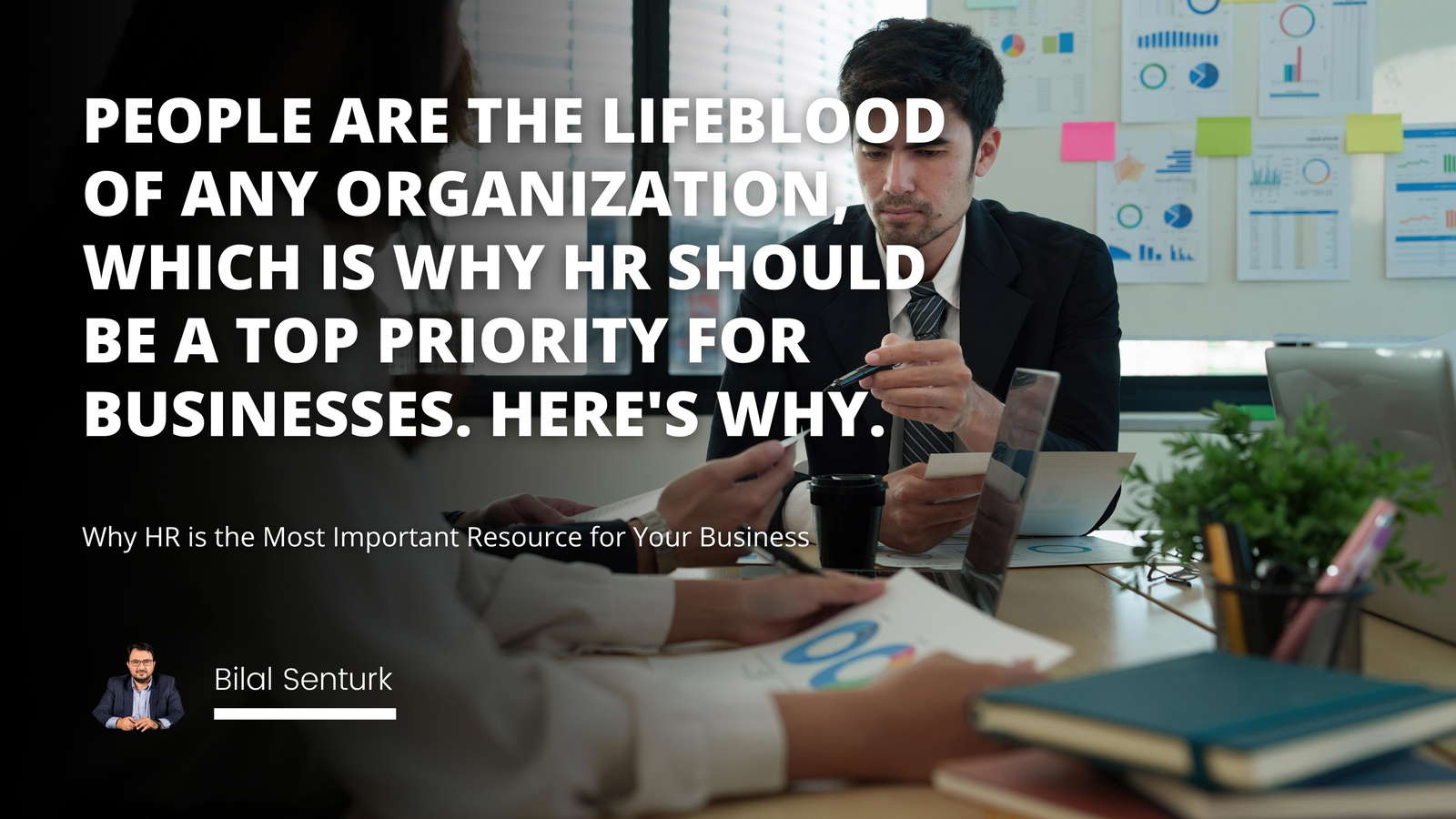
HR As a Driving Force of Business Success
HR as a Bridge in Business Relationships & Client Relations
HR as a Source of Business Ideas & Problem-Solving
Corporate HR, or human resources, is necessary for any successful business. Human resources are the individuals and departments responsible for managing people within an organization. Critical responsibilities of HR departments include hiring, training, resolving conflict, maintaining client relationships, and administering employee benefits packages. Therefore, it is an integral part of a business and plays a significant role in the success of any organization.
HR As a Driving Force of Business Success
Corporate HR can be a significant driving force for business success. However, to be effective, an effective HR strategy must be intertwined with the company's business strategy. Companies that don't consider and effectively integrate their business and HR strategies will likely have difficulty reaching their goals.
Of course, effective HR is more than just integrating the proper practices. Companies should also consider adopting and implementing innovative HR practices such as employee performance management software, team processes, and recognition systems to ensure the best possible outcomes. Implementing creative and effective methods can help motivate employees and improve overall performance.
HR as a Bridge in Business Relationships & Client Relations
Business relationships are crucial to success, and HR can help facilitate these. HR can help create and maintain strong relationships between the business and its customers and partners. This includes addressing conflict, settling disputes, and mediating negotiations.
In addition, HR often serves as the bridge between the business and its customers. An effective HR team will maintain customer relationships and foster customer loyalty. This can be done through customer feedback programs, customer appreciation events, and other forms of customer recognition.
HR as a Source of Business Ideas & Problem-Solving
HR can also be a source of valuable insights and ideas. For example, HR practitioners are often the first to recognize or challenge existing business models, processes, or practices. This can be incredibly beneficial, as it provides an opportunity to find new ways of doing things.
A well-functioning HR team can also be an invaluable resource for problem-solving. By brainstorming solutions to business challenges, HR can develop creative, out-of-the-box strategies that may have gone unnoticed.
In short, corporate HR is an important driving force for any business's success. An effective HR strategy should be aligned and integrated into the company's business strategy to drive maximum impact. HR can facilitate strong business relationships and create and maintain customer loyalty. Furthermore, HR can identify and challenge existing business models, practices, and processes and provide problem-solving strategies. Therefore, corporate HR is an essential element in any successful business.
A strong HR department is the heart of a successful business.
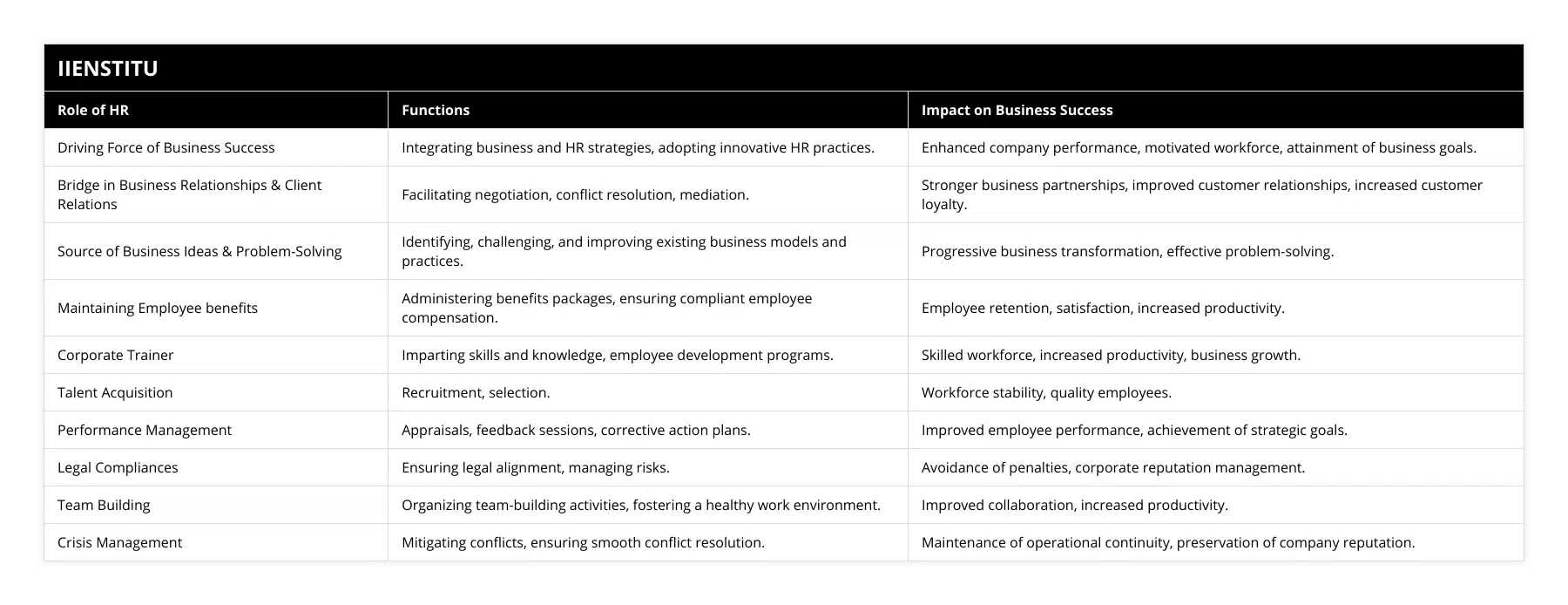
Frequently Asked Questions
What different roles do Human Resource professionals play in the success of a business?
Human resources play a pivotal role in driving a successful business organization. They serve as the link between business objectives and employees. With their expertise, they can ensure a favorable working atmosphere and cultivate successful management of an organization.
Human resources' primary duties are to nurture a productive working environment for employees and manage the organization's personnel matters. To this end, a human resources professional ensures compliance with laws and company policies, supervises existing employees, and hires new personnel as needed. Human resources must also have a hard-working attitude and show communication and problem-solving skills.
A human resources professional's essential functions include recruiting, interviewing, and onboarding employees. With their knowledge of the organization, they are in the best position to find candidates who are well-suited to the organization and can help it thrive. Moreover, they must create an environment conducive to successful hiring and maintain positive relationships with the recruiting teams.
Human resources professionals also provide the necessary training and coaching that new employees need to understand the company's policies and procedures. In addition, they coordinate performance appraisals and negotiate with employees to reach mutually beneficial work-related agreements.
Human resources also play an essential role in ensuring effective team dynamics. They must foster an environment that encourages collaborative problem-solving while also eliminating negative behaviors between personnel. Additionally, they must ensure that departments across the organization are working together to ensure the organization reaches its desired performance goals.
Finally, human resources professionals are necessary for maintaining the company's culture. They ensure the organization's core values, beliefs, and expectations are communicated to current and potential personnel. This goes a long way in instilling a sense of genuine commitment from each employee and aligning them with the company's goals.
Through their dedicated work, human resources professionals oversee the organization's culture, performance, and recruitment efforts. Their role is instrumental in developing and maintaining the success of any business.

How can Human Resource departments ensure the successful selection and retention of talent?
Human Resources can determine the success or failure of any organization. As such, a comprehensive and regularly updated selection and retention process cements a strong foundation for current and future success. Here are a few key ways Human Resources can ensure the successful selection and retention of talent:
Clearly define the requirements: A thorough understanding of the organization's unique needs must be established to ensure that the necessary skillsets, qualifications, and experience are included in potential candidates. The hiring process should also have an in-depth job description review to ensure that requirements are accurately met.
Conduct thorough selection and evaluation: Ensuring candidates possess the necessary skills and experience is essential for hiring correctly. In addition, it is crucial to evaluate candidates' qualities, such as attitude, communication, and teamwork, to ensure that selected candidates are compatible with the organizational culture and working environment.
Conduct regular check-ins: A successful onboarding process should include regular check-ins with the new hire. This allows for Human Resources to provide feedback and advice, as well as reinforce the desired environment and working culture.
Develop an effective onboarding process: It provides employees with the tools they need to become productive team members. This includes introducing them to the organization's culture and values and providing training to equip them with the skills necessary to become successful.
Measure and monitor employee performance: Measuring and monitoring employee performance is essential to ensure they are successfully integrated into the team. This should include regular performance reviews, comprehensive feedback, and addressing any issues that can affect their performance.
Facilitate employee growth: Investing in employee growth is essential to ensure that they remain engaged and motivated. This includes providing employees with opportunities for career advancement, as well as investing in their professional development.
Overall, a comprehensive and regularly updated selection and retention process is critical to ensuring the successful selection and retention of talent. By following the steps mentioned above, Human Resources departments can strengthen their talent acquisition and retention processes, ultimately leading to organizational success.
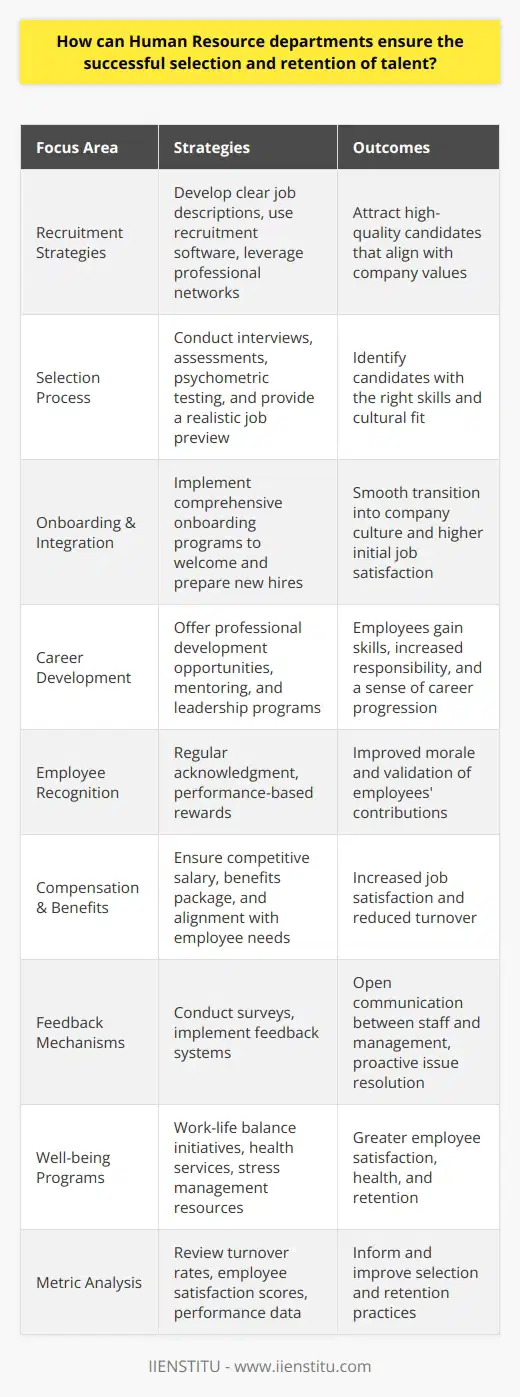
What strategies can Human Resource departments implement to ensure a harmonious work environment?
Creating and maintaining a positive work environment is crucial for any Human Resources (HR) department. In today's rapidly changing global business climate, organizations must ensure that their HR departments adequately utilize strategies to ensure a harmonious work environment. A strategic approach to creating and sustaining a pleasant work environment requires organizations to focus on the employees' individual and collective needs. This article will discuss how an HR department can implement strategies to ensure a harmonious work environment.
The first step in ensuring a harmonious work environment is creating a culture that encourages open communication. Communication between employees should be enabled on all levels. This includes encouraging constructive feedback and open dialogue. In addition, the organization must create an atmosphere conducive to employees feeling comfortable discussing conflicts and issues meaningfully.
The second step is to ensure that adequate training and development opportunities are provided to employees. For example, training should focus on leadership, problem-solving, and conflict resolution. Providing employees with these resources will help to create an environment where employees feel empowered to address potential workplace issues. Additionally, these resources should be supplemented with workshops and seminars on effective communication, working in groups, and other topics relating to creating a harmonious work environment.
Thirdly, HR departments should strive to promote diversity and inclusion in the workplace. Diversity and inclusion can be facilitated through various activities, such as recruiting from a broader range of communities and providing training and development opportunities for minorities. Additionally, the organization must create an environment where all employees feel safe and respected. Finally, HR departments should provide employees with the necessary tools to address any issues of discrimination they may experience.
Finally, HR departments need to be aware that conflicts in the workplace are unavoidable. When disputes arise, the organization should have an established conflict resolution process and implement measures to prevent further issues. This involves having a trained team of mediators available to help employees resolve their differences constructively and cordially. Additionally, HR departments must keep track of any issues and work to identify any common themes or underlying issues.
In conclusion, creating and sustaining a harmonious work environment requires a strategic and proactive approach from the HR department. By implementing strategies such as encouraging open communication, providing adequate training and development, promoting diversity and inclusion, and having effective conflict resolution processes in place, organizations can take the necessary steps to ensure a productive and supportive atmosphere for their employees.

How does HR contribute to business success through talent acquisition and management?
HR's Impact on Business Success
Human Resources (HR) plays a crucial role in contributing to business success by strategically engaging in talent acquisition and effective management practices. In a competitive business environment, sourcing the right talent is vital for an organization's long-term growth and success. Through systematic recruitment processes and market research, HR acquires top talent that possesses the required skill sets and experiences that align with the company's mission and vision.
Talent Acquisition Strategies
To achieve business success, HR deploys various talent acquisition strategies. These include creating a robust employer brand, leveraging professional networks, and utilizing online platforms to showcase the organization's culture and opportunities. A strong employer brand attracts potential candidates, providing the company with a competitive edge in the talent market. By proactively identifying talent from diverse backgrounds, HR ensures continuous innovation and adaptability within the organization.
Retention and Development Efforts
However, talent acquisition alone is not sufficient. Retention and development efforts are equally important in building a skilled and satisfied workforce. HR plays a critical role in implementing comprehensive performance management systems that facilitate regular feedback, goal-setting, and monitoring of employee progress. This not only ensures the continuous growth of employees but also contributes to the overall performance and productivity of the organization.
Career Growth Opportunities
In addition, HR identifies and creates career growth opportunities for employees. This includes designing job rotations, mentorship programs, and targeted training initiatives that enable employees to expand their skill sets and stay engaged in their roles. As employees evolve within the organization, they become valuable assets, driving the company towards operational excellence.
Ensuring Employee Wellbeing
Moreover, HR safeguards employees' wellbeing through the creation and enforcement of workplace policies and procedures that promote a healthy and safe work environment. These can include policies on ergonomics, stress management, and diversity and inclusion. By ensuring employee wellbeing, HR fosters a productive and engaged workforce that contributes positively to business success.
In conclusion, HR contributes significantly to business success through both talent acquisition and effective talent management practices. By attracting and retaining skilled individuals and offering them opportunities for growth, HR builds a strong, satisfied, and motivated workforce that is integral to a company's continued growth and success.
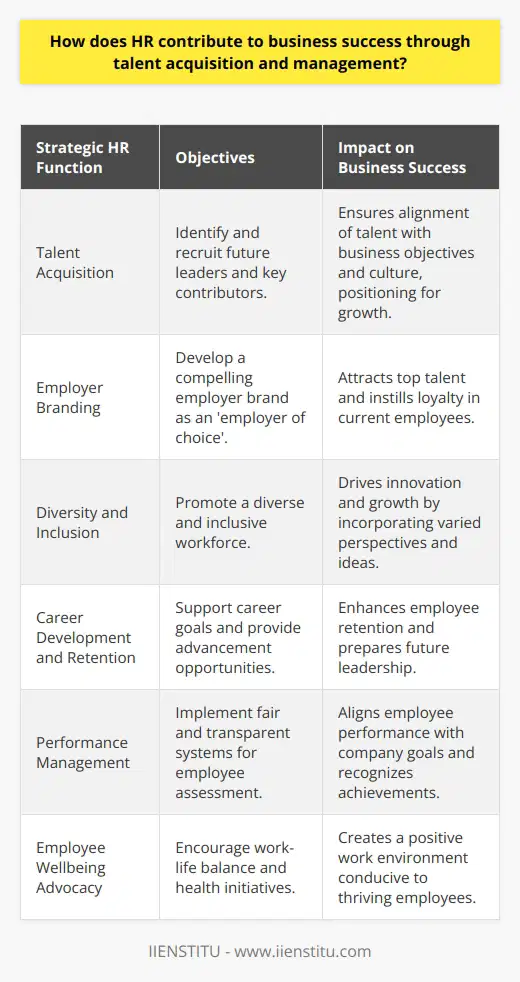
What are the main driving forces of human resource policies in shaping organizational culture?
Role of Human Resource Policies
Among the crucial factors that influence organizational culture, human resource policies emerge as key determinants. From talent acquisition to employee retention, these policies dictate the overall working environment and employee experience within an organization.
Influencing Organizational Values
HR policies contribute significantly to an organization's values by establishing guidelines for behavior and expectations. They help to create a sense of shared values and beliefs among employees by defining acceptable conduct and promoting ethical practices.
Fostering Employee Engagement
An essential component of organizational culture is employee engagement. Through various policies, such as development opportunities, performance management, and rewards systems, the HR department plays a vital role in maintaining engaged and motivated employees. These policies ensure that employees remain satisfied with their work, leading to a strong, positive culture within the organization.
Building Strong Communication Systems
Organizational culture thrives on open and transparent communication. HR policies support this by implementing communication systems that facilitate a continuous flow of information between employees and management. This includes channels for feedback, grievance redressal, and workplace collaboration, which promote trust and transparency in the organizational culture.
Promoting Diversity and Inclusion
An increasingly important aspect of organizational culture is fostering diversity and inclusion. HR policies, such as recruitment practices and employee support programs, strive to create a diverse and inclusive work environment. This ensures that individuals from a variety of backgrounds and perspectives are valued, leading to richer decision-making and creativity.
Creating Safe and Healthy Work Environments
Lastly, HR policies play a crucial role in establishing a safe and healthy working environment by implementing wellness programs and guidelines for workplace safety. This conveys a strong message that the organization prioritizes the health and well-being of its employees, contributing to a supportive organizational culture.
In conclusion, human resource policies in shaping organizational culture serve as the foundation for creating values, fostering employee engagement, facilitating communication, promoting diversity and inclusion, and ensuring a safe and healthy work environment. These elements contribute significantly to forming a robust and positive culture within an organization, ultimately leading to increased productivity and success.
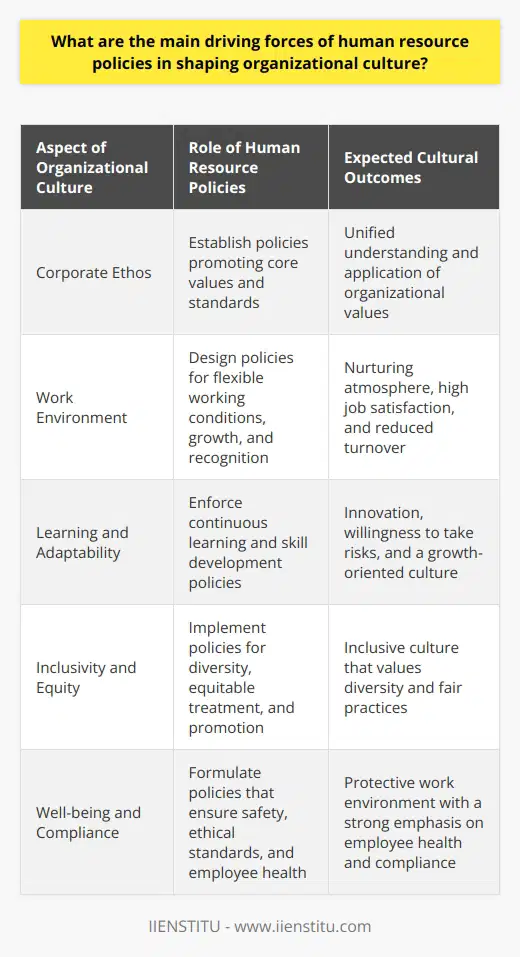
How does HR drive business strategy by aligning employee performance with organizational goals?
Aligning Employee Performance with Organizational Goals
Effect on Business Strategy
Human resource (HR) management plays a crucial role in driving business strategy by ensuring that employee performance aligns with the organization's goals. This alignment is achieved through a variety of HR practices and tools, which facilitate the development and implementation of strategic initiatives.
Selection and Recruitment
HR departments are responsible for selecting and recruiting employees who have the right skills, knowledge, and attitudes to support the company's objectives. By carefully assessing job applicants, HR ensures that the organization is equipped with a talented and committed workforce.
Training and Development
Creating a culture of continuous learning is a key component in linking employee performance to organizational goals. HR departments are responsible for designing, implementing, and evaluating training and development programs that help employees acquire and enhance professional competencies. These programs ensure that staff members remain relevant and capable of adapting to ever-changing business environments.
Performance Management
To ensure that employees' performance is aligned with organizational goals, HR must establish a comprehensive performance management system. This system includes setting, measuring, and evaluating individual and team objectives, as well as providing ongoing feedback on progress. Regular performance reviews assist employees in understanding their roles and responsibilities, and help them identify areas for growth and improvement.
Motivation and Rewards
Recognizing and rewarding exceptional performance is another HR function that helps align employee performance with business objectives. By implementing tailor-made reward and recognition programs, HR departments ensure that employees remain motivated, engaged, and committed to the organization's vision and mission. Incentives can include monetary bonuses, promotions, or opportunities for professional development.
Retention Strategies
Finally, HR management is tasked with retaining top talent to achieve long-term organizational success. Developing effective retention strategies reduces employee turnover and ensures that key positions remain filled by experienced and skilled professionals. This can be achieved through competitive compensation packages, flexible work arrangements, or opportunities for career advancement and personal growth.
In conclusion, HR plays a crucial role in driving business strategy by aligning employee performance with organizational goals. Through strategic selection and recruitment, continuous training and development, robust performance management, motivation and rewards, and effective retention strategies, HR departments help organizations achieve long-term success through a harmonious union of human capital and strategic objectives.
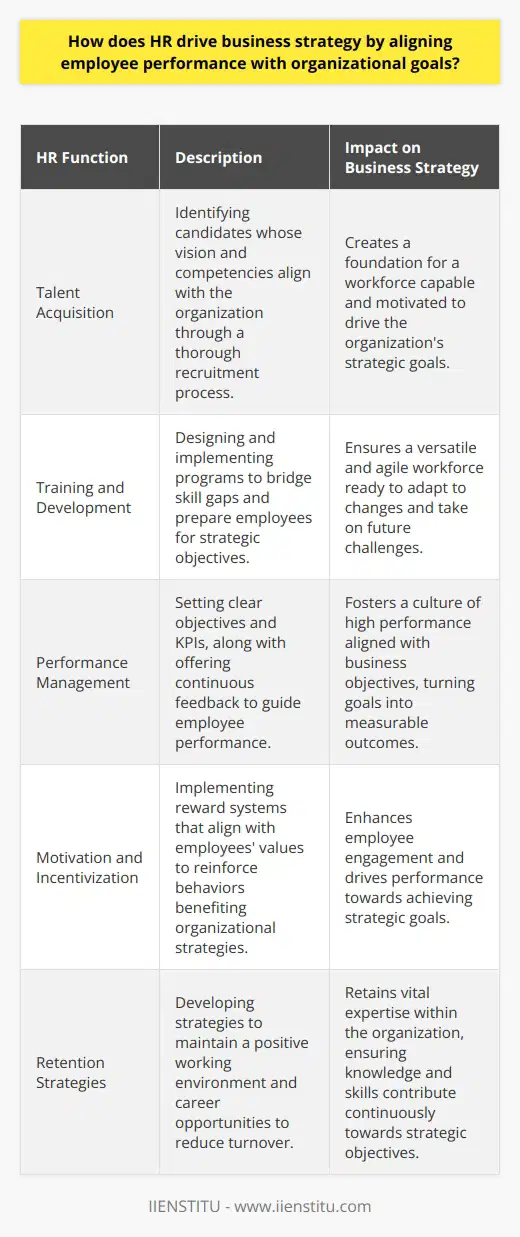
How does human resources drive business value through strategic workforce planning and development?
Strategic Workforce Planning
Human resources (HR) initiates and drives business value by implementing strategic workforce planning and development. This approach enables organizations to align their human capital with organizational goals, ensuring optimal productivity and adaptability to changing market conditions. By managing the supply and quality of the workforce, HR facilitates the achievement of both short-term and long-term business objectives.
Talent Acquisition and Retention
An integral aspect of strategic workforce planning is talent acquisition and retention. HR departments must identify and attract suitable candidates with the required skills and competencies, as well as retain top talent through employee engagement and satisfaction initiatives. A robust workforce development plan fosters collaboration, communication, and innovation, which in turn positively impact an organization's competitive advantage and overall performance.
Employee Skills Development
To optimize business value, the development of employee skills is crucial. Through dedicated programs and opportunities such as training, coaching, and mentoring, HR empowers employees to strengthen their abilities and knowledge. Building a competent and skilled workforce enables organizations to improve performance, capitalize on new business opportunities, and address emerging challenges effectively.
Succession Planning
One of the key aspects of strategic workforce planning is succession planning – the process of identifying and preparing potential successors for critical roles. This proactive approach ensures continuous leadership and preserves the organization's strategic direction. By regularly evaluating employees' potential and promoting them to leadership positions, HR maintains a pipeline of talent that fuels the organization's growth and success.
Diversity and Inclusion
Fostering an environment where diversity and inclusion are encouraged is crucial for businesses in today's globalized economy. HR plays a vital role in driving these initiatives. Through diversity and inclusion strategies, HR not only shows commitment to social responsibility but also enhances the organization's ability to attract and retain talent. This results in increased creativity, more effective decision-making, and better collaboration—all vital components of driving business value.
Performance Management
Finally, HR plays a critical role in enhancing business value through effective performance management. By establishing clear expectations, monitoring employee performance, and providing constructive feedback, HR can ensure that the workforce remains motivated, engaged, and productive. Performance management also helps employees understand how their individual efforts contribute to the organization's overall success.
In conclusion, HR drives business value through skilled workforce planning and development. By attracting and retaining the best talent, enhancing employee skills, managing succession plans, fostering diversity and inclusion, and effectively monitoring performance, organizations can efficiently confront market challenges and achieve sustainable growth.
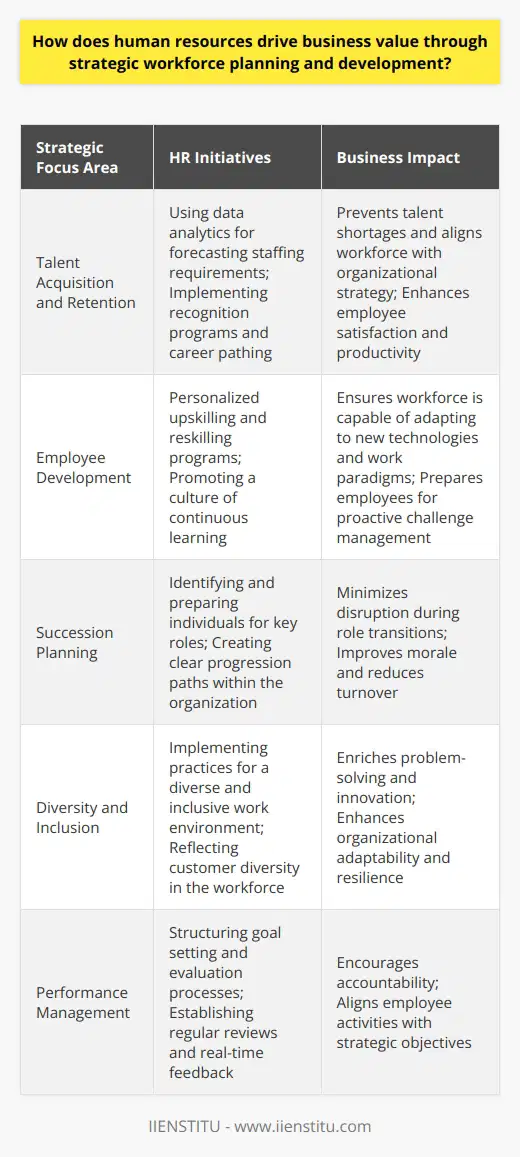
Why is the effective management of human resources essential for achieving and sustaining competitive advantage?
Significance of Effective HR Management
Effective management of human resources is essential for achieving and sustaining competitive advantage because it allows organizations to strategically deploy their talent, align employees with company objectives, and foster an environment that nurtures innovation and continuous improvement. By carefully designing and implementing human resource practices, companies can create a highly skilled, motivated, and dedicated workforce capable of adapting to the rapidly changing demands of the market.
Strategic Talent Deployment
A key aspect of effective human resource management involves identifying, attracting, and retaining the right talent to support an organization's strategic objectives. This requires a thorough understanding of the company's business plan, industry landscape, and anticipated workforce requirements. By aligning employee skills and competencies with corporate goals, organizations can maximize the potential of their workforce and maintain their competitive edge.
Employee Alignment with Company Objectives
When employees understand and support the company's strategic goals, they exhibit increased motivation, satisfaction, and commitment. Effective human resource management practices promote the alignment between organizational objectives and employee activities by providing ongoing communication, training and development, performance evaluation and feedback. As a result, employees become more engaged in their work and invest greater effort towards achieving company targets.
Fostering Innovation and Continuous Improvement
In today's competitive market, organizations must continually adapt and refine their products, services, and business processes to maintain their market share. Effective human resource management contributes to the development and retention of an innovative workforce by fostering a workplace culture that values creativity, collaboration, and continuous learning. This culture encourages employees to seek new opportunities, challenge the status quo, and propose innovative solutions to business challenges.
Benefits of a Motivated and Skilled Workforce
Finally, the effective management of human resources enables organizations to reap substantial benefits from their investments in people. A highly skilled and motivated workforce not only contributes to business growth and profitability but also serves as a powerful source of differentiation, helping companies maintain a competitive edge in their respective markets. By investing in the development and well-being of their employees, organizations can achieve and sustain competitive advantage over their rivals.

What role does human resource management play in fostering innovation and organizational agility?
Role of HRM in Innovation
Human resource management (HRM) plays a crucial role in fostering innovation by recruiting, selecting, and retaining employees with the skills and creativity necessary to generate new ideas. The HRM function is responsible for ensuring a highly skilled, diverse, and motivated workforce, which directly contributes to an organization's ability to innovate.
Training and Development
To create an environment that supports innovation, HRM should prioritize training and development initiatives that equip employees with the technical expertise and problem-solving abilities required to address complex organizational challenges. Such programs not only enhance the overall competency of the workforce but also cultivate a culture of continuous learning, which is vital for fostering creativity and staying ahead of the competition.
Performance Management
HRM is also responsible for designing performance management systems that reward employees for their innovative ideas and contributions. Linking performance metrics to creativity can incentivize individuals to think beyond conventional solutions and inspire them to develop novel approaches. This practice not only encourages innovation but also helps in building an adaptive and future-oriented organization.
Organizational Culture
Human resource management contributes significantly to shaping organizational culture by promoting values that support innovation, such as collaboration, openness, and risk-taking. HRM can facilitate a culture of innovation by implementing policies that encourage cross-functional teamwork, knowledge sharing, and the acceptance of occasional failure as a natural part of the innovation process. Ensuring that the organization’s culture is inclusive and diverse is also essential, as it fosters an environment in which innovative ideas from a wide range of sources can be acknowledged and nurtured.
Change Management
Lastly, HRM plays a pivotal role in managing change in organizations. With the continuous emergence of new technologies and globalization, change has become an inevitable aspect of organizational life. By effectively managing change processes, HRM can ensure that employees are prepared and equipped to adapt to rapid shifts and navigate through uncertainties. This responsiveness and agility are critical for organizations to sustain long-term competitive advantage and foster innovation in a dynamic business landscape.
In conclusion, human resource management is integral to fostering innovation and organizational agility by creating a skilled and motivated workforce, providing training and development opportunities, designing effective performance management systems, and nurturing a culture of collaboration, diversity, and risk-taking. By adapting to changes and facilitating continuous learning, HRM ensures that organizations can capitalize on opportunities, overcome challenges, and remain competitive in today's dynamic and evolving market.
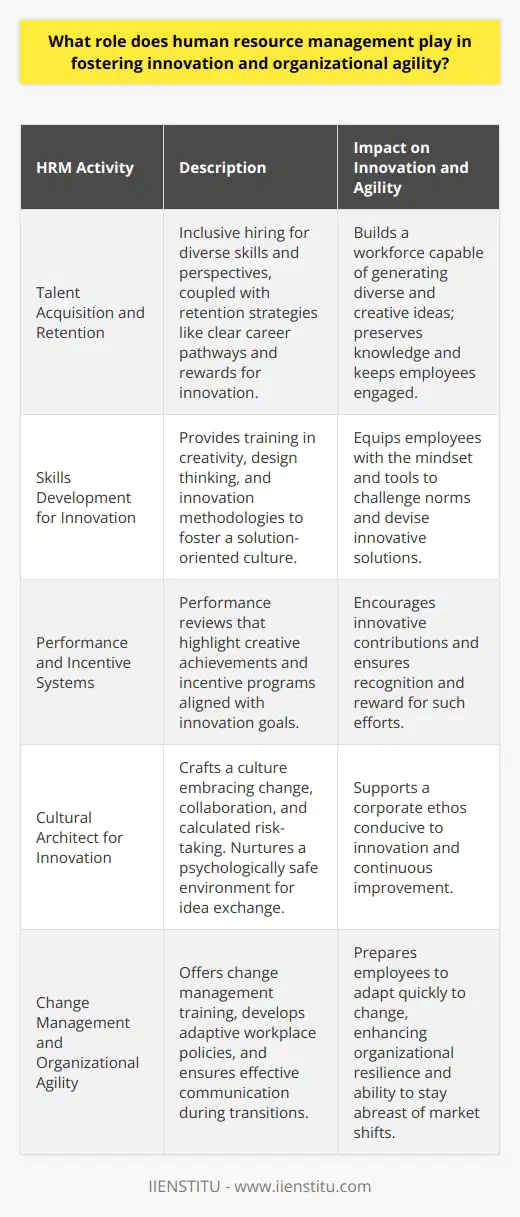
How does HR contribute to business success by facilitating employee engagement and satisfaction?
Role of HR in Employee Engagement and Satisfaction
Employee engagement and satisfaction play significant roles in the success of any business by impacting aspects such as productivity, innovation, and employee retention. Human Resource (HR) departments contribute to business success through facilitating strategies and practices that promote employee engagement and satisfaction.
Driving Employee Satisfaction
HR departments are responsible for designing and implementing policies that lead to higher levels of employee satisfaction. Fair compensation, an inclusive work culture, flexible work hours, professional development opportunities, and timely performance appraisal contribute significantly to employee satisfaction. By proactively addressing employee concerns and maintaining an open line of communication, HR departments can ensure that employees feel valued and supported.
Fostering Employee Engagement
Employee engagement is the level of commitment and passion that an individual shows towards their organization and its objectives. HR departments play a crucial role in promoting employee engagement through transparent communication, effective performance management systems, and recognition of employee achievements. By creating an environment where employees feel a strong sense of belonging and accountability, HR departments can increase employee engagement levels within the organization.
Training and Development Opportunities
One of the leading drivers of both employee engagement and satisfaction is continuous professional development. HR departments should create learning opportunities and career development programs regularly. By offering skill development workshops, mentorship programs, or tuition reimbursement initiatives, HR contributes to employee growth and satisfaction levels.
Achieving Work-Life Balance
Work-life balance is an essential aspect that contributes immensely to employee satisfaction and engagement. HR departments can play a vital role in helping employees strike a balance between their personal and professional lives through implementing policies such as flexible schedules, remote work options, and ensuring sufficient vacation time. These actions can lead to increased work satisfaction, reduced absenteeism, and increased overall well-being of employees.
In conclusion, HR departments play a central role in facilitating processes that contribute to employee engagement and satisfaction. By designing favorable workplace policies and promoting an inclusive, supportive work culture, HR departments can positively impact business success by fostering engaged and satisfied employees.
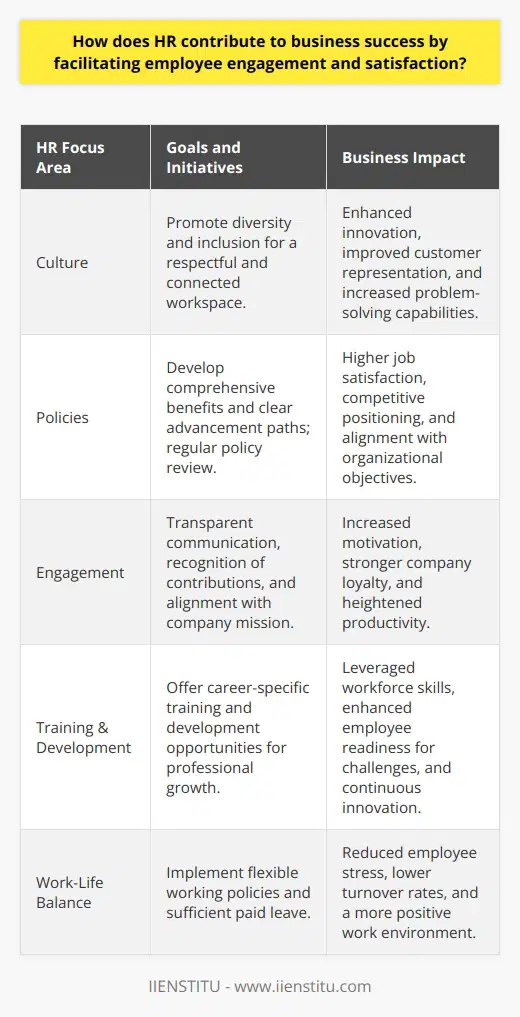
Why is the strategic role of human resources critical in driving organizational performance and productivity?
Strategic Human Resources for Performance Enhancement
The strategic role of human resources (HR) plays a significant part in improving organizational performance and productivity. Firstly, HR fosters a people-centered work environment, which contributes to enhanced employee satisfaction and motivation. This aspect is crucial because satisfied and motivated employees are more likely to put in the needed effort in achieving organizational objectives, leading to increased productivity.
Talent Acquisition and Retention
Another critical contribution of strategic HR is effective talent acquisition and retention. HR professionals use their expertise in acquiring skilled and talented employees who can align with the organizational culture and contribute positively to the company's growth. Moreover, they implement various retention strategies, including training and development programs that continually enhance employee skills and competencies. These factors collectively help maintain a high-quality workforce, which subsequently drives better overall performance within the organization.
Employee Engagement and Collaboration
Strategic HR also focuses on promoting employee engagement and collaboration across teams. By nurturing open communication channels, trust, and transparency among employees and management, HR contributes to a healthier work environment. These efforts result in improved problem-solving, teamwork, and innovation, ultimately leading to higher performance and productivity.
Performance Management Systems
Effective performance management systems implemented by HR enable organizations to track employee performance, set performance objectives, and provide continuous feedback. Through this system, employees receive regular insights into their strengths and areas for improvement, which fosters personal and professional growth. The performance management process, therefore, plays an integral role in ensuring that employees remain productive and deliver optimum results.
In conclusion, the strategic role of human resources is essential in driving organizational performance and productivity. Through fostering a people-centered work environment, effective talent acquisition and retention, promoting employee engagement and collaboration, and implementing performance management systems, HR can be instrumental in enhancing an organization's overall success.
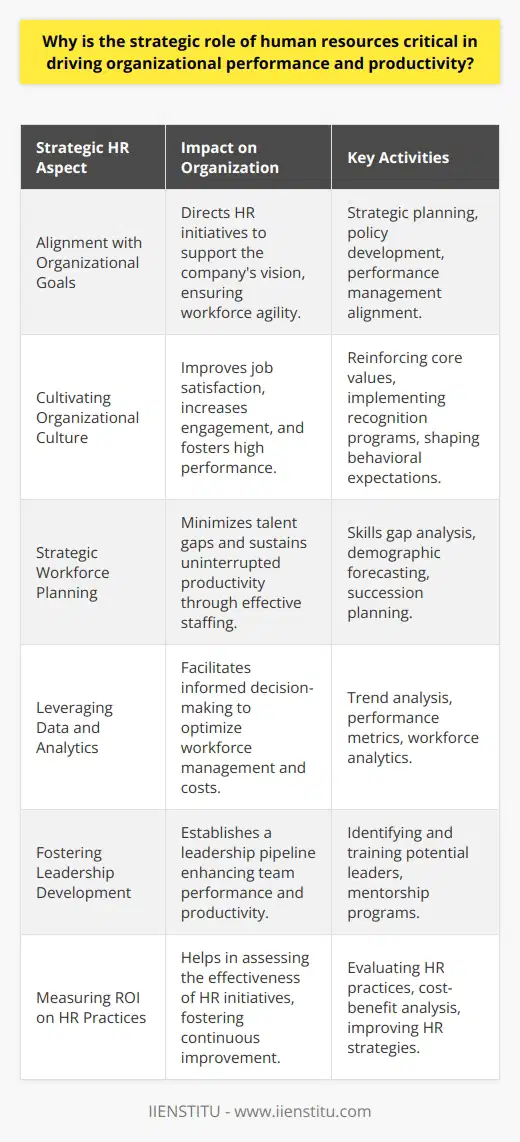
How do effective human resource management practices contribute to the development and retention of a diverse and skilled workforce?
**Effective Recruitment Strategies**
Effective human resource management practices contribute to the development and retention of a diverse and skilled workforce through implementing strategic recruitment strategies. By targeting a wide range of candidates and adopting a culture of inclusivity, organizations can attract applicants from different backgrounds, skill sets, and experiences. Such diverse teams bolster creativity, productivity, and lead to innovative solutions.
**Continuous Learning Opportunities**
Another crucial aspect of human resource management is providing continuous learning opportunities. Companies offering training programs, workshops, and educational resources empower employees to enhance their skills and knowledge. This promotes a growth mindset, as employees understand that their professional development is regarded as essential, thus leading to higher retention rates.
**Equal Opportunities and Fair Wages**
Adopting equal opportunity policies and ensuring fair wages also play a significant role in retaining a diverse and skilled workforce. By embracing pay transparency and committing to equal pay for equal work, employees feel valued and appreciated, which fosters loyalty towards the organization. Moreover, this approach minimizes the chances of pay discrimination and creates a fair and equitable work environment.
**Performance Management System**
A well-implemented performance management system is another essential human resource management practice. This system allows organizations to set clear performance expectations, monitor progress, and provide regular feedback, fostering an environment of continuous improvement. Employees who benefit from this system are more likely to be engaged and committed to their work, leading to better retention rates.
**Acknowledging and Rewarding Achievements**
Furthermore, acknowledging and rewarding achievements is essential for staff morale, motivation, and retention. When employees feel that their efforts are recognized, they are more likely to display a higher level of commitment and job satisfaction. Therefore, effective human resource management should also focus on celebrating individual accomplishments and team success.
**Work-Life Balance and Employee Wellness**
Finally, effective human resource management practices should support employees’ well-being and work-life balance. This includes promoting flexible working hours, providing health and wellness programs, and encouraging staff to prioritize mental and emotional health. When employees feel that their organization cares for their overall quality of life, they are more inclined to remain loyal and engaged.
In conclusion, effective human resource management practices contribute to the development and retention of a diverse and skilled workforce by employing various strategies, including comprehensive recruitment, continuous learning, equal opportunities and fair wages, performance management, recognition of achievements, and work-life balance. These practices collectively foster a positive work environment, which results in improved employee performance, engagement, and retention.
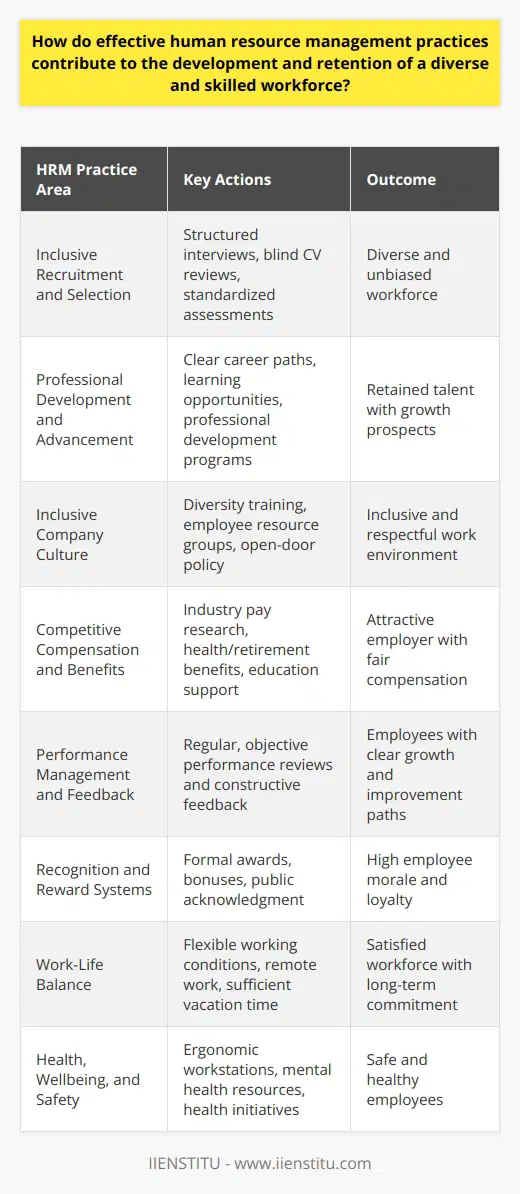
How does human resources drive business value by enhancing employee well-being and work-life balance?
Impacting Economic Indicators through HR
Human resources (HR) significantly influence an establishment's business value through employee well-being and work-life balance enhancement strategies. High employee satisfaction levels correlate simultaneously with improved performance, productivity, and staff retention. These three parameters directly impact an organization's bottom line.
Forging Job Satisfaction and Performance
HR practices instrumental in enhancing job satisfaction not only boost individual performance but also rectify productivity levels. Ensuring job satisfaction often requires implementing initiatives that address problems impacting employee performance and dissatisfaction. Such well-targeted strategies improve individual effectiveness, subsequently enhancing firm-wide performance and productivity.
Increasing Retention Rates
Furthermore, a well-balanced work-life environment significantly decreases staff turnover rates. HR aims to make sure employees do not feel overworked or stressed, maintaining a healthy balance between their personal and professional lives. When employees experience this balance, they demonstrate high loyalty levels, vastly decreasing the likelihood of leaving the company.
Direct Impacts on Business Value
Consequently, these HR activities directly influence the organization's business value. An uptick in job satisfaction can lead to enhanced performance, translating into a higher-quality output or service, positively impacting the company's financial health. Meanwhile, reduced staff turnover decreases recruitment costs, thereby improving bottom-line profitability.
In conclusion, by implementing effective HR strategies that nurture employee well-being and promote work-life balance, companies can significantly drive their business value. Enhancements in performance, productivity, and retention rates directly contribute to a company's financial health, reaffirming the impact of HR on business value.
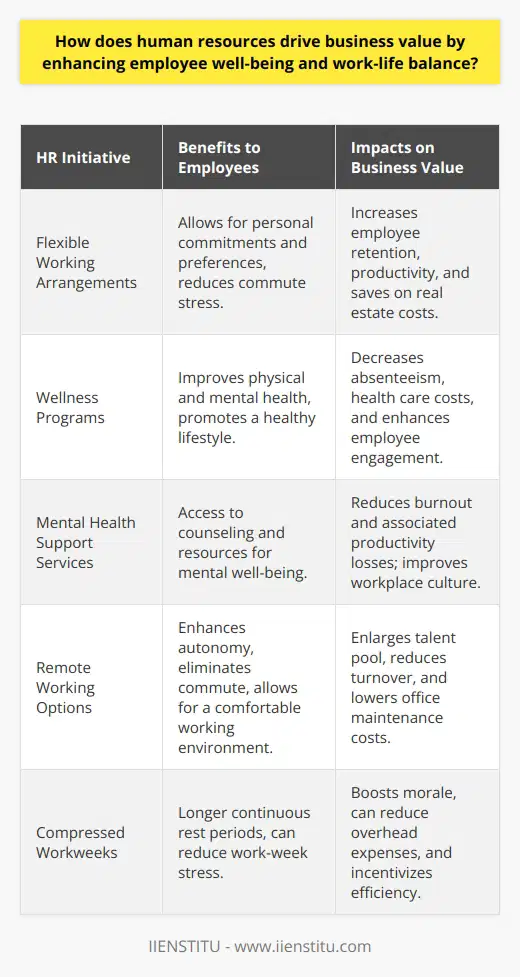
What are the main driving forces of human resource in addressing ethical considerations and corporate social responsibility within business operations?
Promoting Ethical Behavior
The principal driver of human resources in promoting ethics is creating and reinforcing an ethical organizational culture. Fostering an ethical culture involves establishing codes of conduct, principles, and ethical guidelines that everyone should adhere to. It requires identifying unethical practices and swiftly dealing with any infringements. Moreover, ethical leadership emanating from top management ensures employees emulate these values.
Human Resource Management in CSR
On corporate social responsibility (CSR), human resources play a pivotal role in embodying these values within the firm's structure and processes. Employees are key to a company's CSR initiatives. Thus, their engagement, training, and motivation become vital. Human resources are responsible for equipping the workforce with the knowledge, skills, and attitudes necessary to fulfill the firm's CSR objectives.
Enhancing Compliance and Legal Awareness
Human resources also ensure the firm abides by legal and industrial regulations. They provide consistent communication of rights, duties, and responsibilities to the workforce. Knowing and understanding these matters can help employees make ethical choices. Moreover, ensuring labor practices comply with legal standards is also an important part of CSR.
The Role of Recruitments and Promotions
The recruitment and promotion process plays a significant role in the ethical stance of the organization. Human resources need to ensure these processes are fair, transparent, and provide equal opportunities. Likewise, recognizing and rewarding ethical behavior enhances the promotion of ethics within the organization.
In conclusion, human resources have a multifaceted role in enhancing the ethical considerations and CSR in business operations. These roles include promoting ethical behavior, encouraging CSR, enhancing compliance and legal awareness, and ensuring fairness in recruitment and promotions.

How does HR contribute to business success through the implementation of effective performance management systems and employee training initiatives?
Employee Performance Management Systems
HR significantly influences business success by implementing effective performance management systems (PMS). Consistent monitoring and evaluating employees' performance enhances productivity. Such systems align individual tasks with business goals, ensuring everyone works in harmony towards shared objectives. They establish expectations, reduce ambiguity, and provide ongoing feedback, fostering an environment conducive for growth.
Employee Training Initiatives
Moreover, HR's role in business success extends to organizing employee training initiatives. Regular training ensures continual skill development and knowledge enhancement. It leads to increased specialization, ultimately elevating the organization's competitive edge. By identifying the areas for improvement, HR tailors programs that boost employees’ potential, improving business outcomes.
Employee Engagement and Motivation
Furthermore, HR contributes by promoting employee engagement and motivation. Their role in the recognition, reward, and promotion system positively affects employee morale. An employee who feels valued will undeniably put in extra effort, increasing overall productivity.
Organizational Communication
HR also facilitates organizational communication, another crucial factor for business success. Through effective communication, conflicts are reduce. HR ensures a seamless flow of information, fostering a culture of trust and transparency.
Conclusion
In conclusion, HR is instrumental in sustaining business success. Implementing robust performance management systems and consistent training initiatives, alongside promoting healthy communication and employee engagement, is pivotal in driving an organization towards its goals. Businesses should thus emphasize strengthening their HR functions for better performance.

